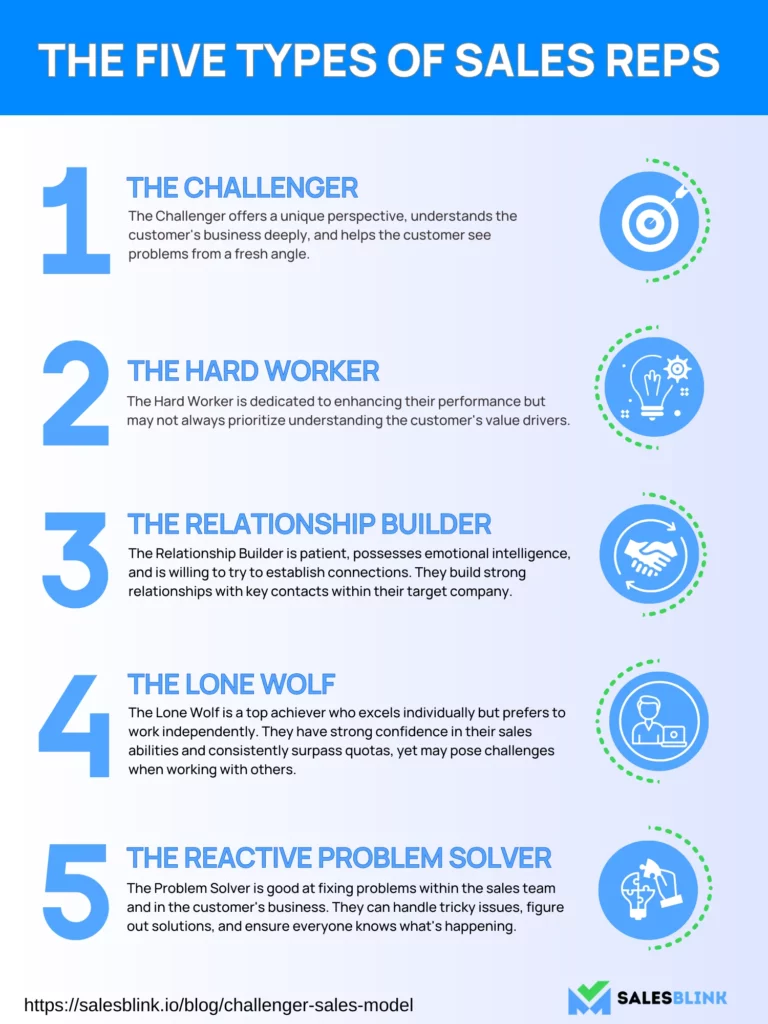According to Gartner’s research, B2B buyers allocate just 17% of their time to engage with potential suppliers when evaluating a purchase. Conversely, 27% of their time is dedicated to independent online research.
This shows that when potential customers consider a purchase, they already know what they want and how much they want to spend. They do a lot of research online before talking to sellers.
In this situation, the Challenger sales model works well. Customers don’t need a salesperson to list product features because they already know from their online research. They have access to a lot of information online. However, they often feel overwhelmed by all the options and need help deciding.
When they do talk to a salesperson, they want a good buying experience and answers to why they should buy, not just what to buy.
So, is the Challenger sales method the right approach for these new buying behaviors? Let’s look into that more closely.
Table of Contents
- What is the Challenger sales model?
- The Five Types Of Sales Rep
- What Behaviors and Characteristics Do Challengers Display?
- How is the Challenger sales model different from others?
- Who can use the Challenger sales model?
- Benefits of the Challenger sales model
- Three Reasons Why The Challenger Sales Model Can Fail
- How To Transform Your Sales Team Into Challengers?
- How to adopt the Challenger sales methodology in 5 steps
- Challenger Sales Question Examples
- FAQs
What is the Challenger sales model?
The Challenger sales model is a customer-focused approach to sales that trains salespeople to challenge their customers’ current thinking while using data and insights to create personalized solutions.
This sales process, developed by Brent Adamson and Matthew Dixon, is built on the practices of top-performing sales professionals known as “Challengers.”
Adamson and Dixon conducted extensive surveys of sales reps to identify the key skills, behaviors, attitudes, and activities that lead to strong sales performance. They identified five categories:
- The hard worker
- The relationship builder
- The lone wolf
- The problem solver
- The challenger
Adamson and Dixon discovered that Challengers outperform other sales reps by utilizing their deep understanding of customer pain points and adapting their communication to better resonate with customers. This approach is at the core of the Challenger sales model.
The Five Types Of Sales Rep

Here are the five types of sales reps:
1. The Challenger
Being a Challenger means you show your customers a fresh way of looking at things and aren’t afraid to talk about money. Understanding what’s important to them is key, and leveraging that knowledge to craft an enticing pitch is crucial. Tailoring your approach to address each customer’s unique concerns is essential. Moreover, employing subtle methods to guide them in the correct path is equally important. This sales rep offers a unique perspective, understands the customer’s business deeply, and helps the customer see problems from a fresh angle. Remember the “Three T’s”: Provide valuable teaching, tailor your sales pitch, and take control of the conversation.
2. The Hard Worker
The Hard Worker is dedicated to enhancing their performance but may not always prioritize understanding the customer’s value drivers. They are determined to work procedures and achieve their sales targets.
3. The Relationship Builder
When you envision a typical salesperson, you often picture the Relationship Builder. They are patient, possess emotional intelligence, and are willing to try to establish connections. These sales representatives build strong relationships with key contacts within their target company, gradually working to cultivate internal advocates.
4. The Lone Wolf
They are the top achiever who excels individually but prefers to work independently. They have strong confidence in their sales abilities and consistently surpass quotas, yet may pose challenges when working with others. Their reluctance to collaborate, however, often fuels their creativity and resourcefulness.
5. The Reactive Problem Solver
The Problem Solver is good at fixing problems within the sales team and in the customer’s business. They can handle tricky issues, figure out solutions, and ensure everyone knows what’s happening.
What Behaviors and Characteristics Do Challengers Display?

The Challenger model revolves around a particular type of salesperson, the Challenger, with six defining characteristics. Let’s explore these qualities:
- Strong Communication Skills: Challengers excel in two-way communication. They are good at listening and conveying their ideas effectively.
- Understanding Customer Values: They know what matters most to each customer, what drives their decisions, and what they value in a product or service.
- Recognizing Economic Drivers: Challengers are keen on identifying the key economic factors that impact a customer’s business.
- Comfort with Money Talks: They are comfortable discussing financial matters with customers, which includes pricing, budgets, and cost-effectiveness.
- Bringing Unique Perspectives: Challengers bring fresh and unique perspectives to the table, challenging customers’ views and ways of thinking.
- Persuasive Decision-Making: They can persuade customers to make decisions, guiding them toward a choice.
The Challenger sales model is structured around these characteristics and is built upon four core principles:
- Teaching: Challengers educate customers, providing valuable insights and knowledge beyond a typical sales pitch.
- Tailoring: Instead of offering generic solutions, they customize their approach to meet each customer’s needs and preferences.
- Taking Control: Challengers take charge of the sales process, leading the customer through a thoughtful and engaging journey.
- Probing: They ask probing questions, encouraging customers to think deeply and consider new possibilities, moving them out of their comfort zones.
Therefore, the Challenger sales methodology transforms the sales approach. Challengers act as consultants and advisors rather than merely presenting a product or service. They aim to deeply understand their customers’ unique requirements and then craft tailored solutions that align with them.
This consultative challenger sales approach promotes a more thought-provoking and interactive environment, making it more likely for customers to make informed decisions that benefit their businesses. By embracing these principles and characteristics, businesses can enhance their sales strategies and build stronger, more valuable customer relationships.
How is the Challenger sales model different from others?
The Challenger sales model stands out from many other contemporary sales approaches by taking a unique and highly effective approach. While other methods often assume that customers already know what they need and focus on presenting the ideal solution, the Challenger model distinguishes itself through a different perspective.
The Challenger sales model transforms the sales process into something that feels more like a valuable consultation than a traditional sales pitch. Here’s how it differs from other approaches:
- Consultative Approach: Challengers offer something more profound instead of telling customers what they want to hear or rehashing what they already know. They introduce new ideas and insights that customers may have yet to consider. This approach challenges customers’ thinking and encourages them to explore new possibilities.
- Creating Inspiring Moments: While other sales strategies aim for agreement and affirmation, the Challenger model strives for those “aha” moments. It prompts prospects to say, “I’ve never thought about it like that.” In doing so, it positions the sales representative as the expert in the room, capturing the customer’s attention and inspiring them to take action.
- Proactivity: The Challenger sales model encourages salespeople to take the initiative in the deal and the conversation. It empowers them to fearlessly engage with potential customers, challenge their current solutions, and present superior alternatives.
This approach fundamentally changes the dynamic of the sales interaction. It’s not about pushing a product or service but facilitating a meaningful dialogue. By offering fresh insights and thought-provoking perspectives, Challengers guide customers toward making informed decisions that align with their needs and goals.
Thus, the Challenger sales model is special because it focuses on teaching, shaking things up, and making the salesperson a trusted guide. It’s different from your usual way of selling. It’s all about giving something valuable in every talk with prospects. This method is often used in sales training and helps star performers succeed in the sales cycle.
Who can use the Challenger sales model?

The Challenger sales process is a helpful approach for many businesses and salespeople. It’s like a tool anyone in sales can use to do their job better. Here’s why it can be useful:
- Sales reps: Sales reps from various industries, like technology, healthcare, or finance, can use the Challenger model to improve how they sell. It helps them connect with customers and offer solutions that fit their needs.
- Sales Teams: Entire sales teams can adopt the Challenger model. It can become part of their sales training to make sure everyone understands how it works. This way, the team can work together to sell more effectively.
- Small Businesses: Even small businesses can benefit. If you’re selling products or services, understanding your prospects better and offering them something they might not have thought of can help your business grow.
- Big Companies: Large corporations can use the Challenger model, too. It can help them sell to other big businesses or individual consumers. The principles of teaching, challenging, and providing value work in many situations.
- Experienced Salespeople: Seasoned sales professionals can fine-tune their skills using the Challenger model. It helps them stay at the top of their game and adapt to changing customer needs.
- New Salespeople: People starting in sales can also find value in the Challenger model. It offers a structured approach that can guide them in building successful customer relationships.
In short, the Challenger sales model isn’t limited to a specific group. It’s a versatile approach that anyone in sales can use to connect better with customers, understand their needs, and offer solutions that truly help. It’s a valuable tool that can make selling easier and more effective for everyone.
Benefits of the Challenger sales model

Here are a few benefits of the Challenger sales model:
1. Increase Win Rates
The Challenger sales model offers several key benefits, and one of the most significant is the ability to increase win rates. By taking a proactive and consultative approach, salespeople can better connect with customers, understand their requirements, and present tailored solutions. It results in a higher likelihood of closing deals successfully. The Challenger approach encourages sales reps to challenge the customer’s thinking, leading to more meaningful conversations that drive positive outcomes.
2. Identify Great Differentiators
Another advantage of the Challenger model is its capacity to help businesses identify and leverage great differentiators. Salespeople learn to highlight what makes their products or services unique and valuable to customers. This differentiation can set a company apart from competitors, making it more appealing to potential buyers.
3. Take Control of a Complex Sales Experience
Complex sales processes can be daunting, but the Challenger model empowers salespeople to take control. By offering insights, guiding customers, and leading the conversation, sales reps can navigate the intricacies of a sale more effectively. This control leads to better decision-making and higher success rates in complex deals.
4. Permit Salespeople to Develop Their Character and Build a Solid Team
The Challenger sales model goes beyond techniques; it encourages salespeople to develop their character and skills. It promotes a culture of continuous improvement, enabling sales teams to become more effective over time. Additionally, it fosters teamwork by aligning sales strategies and goals, leading to a cohesive and high-performing sales force.
Thus, the Challenger sales model offers many benefits, including increased win rates, the identification of compelling differentiators, mastery over complex sales processes, and the development of individual salespeople and cohesive sales teams. These advantages position businesses for greater success in competitive markets.
Three Reasons Why The Challenger Sales Model Can Fail

Three Reasons for Challenger Sales Model Challenges:
1. Not Suitable for Every Sales Rep
The Challenger approach requires strong teaching skills and deep business knowledge. It’s not a one-size-fits-all solution. If salespeople don’t know much about their industry and business, they might find it hard to use the Challenger model well.
2. Balancing Challenge and Respect
Challenging the customer doesn’t mean being rude or disrespectful. Some sales reps need to understand this aspect and may unintentionally offend clients. Instead, the goal is to provide insightful and thought-provoking content that engages customers positively.
3. Mindset Shift Requires Investment
Adopting the Challenger approach demands a significant change in mindset, which can be challenging. Veterans who have been selling a certain way for years may need to unlearn old habits, while newcomers might need to acquire industry knowledge. This transformation requires substantial time, effort, and energy.
A Potential Solution: Coaching
Coaching plays a pivotal role in making the Challenger model work effectively. It involves:
- Guiding sales representatives to ask the right questions.
- Providing support during challenging situations, such as handling objections or negotiations.
- Offering feedback to develop successful sales behaviors, such as knowing when to challenge the customer and how to emphasize value over price.
However, there are two challenges with coaching:
- Sales training is often forgotten quickly.
- Sales managers have limited time to participate in every sales call.
While coaching is a valuable tool, addressing these challenges and ensuring consistent and lasting learning is crucial for successfully implementing the Challenger methodology.
How To Transform Your Sales Team Into Challengers?

Turning your sales team into Challengers who can bring in more sales and build better customer relationships can be done in five steps:
Step 1: Identify the Current Mindset
First, determine where your sales team stands. Understand their current way of thinking and selling. This will help you see what needs to change.
Step 2: Introduce the Challenger Sales Model
Explain to your team what the Challenger model is all about. Ensure they understand it’s not just about selling but also about teaching and providing valuable insights to prospects.
Step 3: Provide Training and Insights
Provide training sessions and resources to help your team learn the Challenger approach. Equip them with the knowledge and skills they need to challenge customers respectfully and effectively. Give them insights into your industry and your customers’ needs.
Step 4: Encourage a Proactive Approach
Encourage your salespeople to be more proactive. They should lead conversations with customers and guide them toward better decisions. This means they need to ask the right questions and offer new ideas.
Step 5: Monitor Progress and Provide Feedback
Keep an eye on how your team is doing. Are they using the Challenger model effectively? Provide regular feedback and coaching. Help them improve by pointing out what’s working and where they can improve.
Remember, it might take time for a team to embrace the Challenger mindset fully. Some members may adapt quickly, while others might need more support. Be patient and keep reinforcing the importance of this approach. Over time, the sales team will become more skilled at being Challengers, ultimately leading to better sales results and stronger customer relationships.
How to adopt the Challenger sales methodology in 5 steps

Here are five steps to adopt the Challenger sales methodology:
Step 1: The Warm-Up
Building a strong foundation is essential before diving into the Challenger sales methodology. The warm-up phase is all about understanding your prospect sand preparing to engage them effectively.
Identify Your Audience: Start by knowing your prospects inside out. Understand their needs, challenges, and goals. This knowledge will be your guiding light throughout the sales process.
Establish Trust: Building trust is crucial. Your prospects should feel comfortable talking to you. Be genuinely interested in their concerns and show empathy.
Step 2: Reframe the Conversation
Challenger sales require you to change the way you talk to prospects. It’s about shifting their perspective and opening their minds to new possibilities.
Challenge Assumptions: Politely question your potential customer’s assumptions and beliefs. This encourages them to think more critically about their needs and how your solution can help.
Offer New Insights: Provide fresh insights and information they might not know. Share success stories and industry knowledge that highlight the value of your offering.
Step 3: Use Emotions
Emotions play a significant role in decision-making. To adopt the Challenger methodology successfully, connect with your prospects emotionally.
Storytelling: Share stories that resonate with your customers. Stories are very powerful because they create an emotional connection and make your message memorable.
Show Empathy: Understand your customers’ pain points and frustrations. Express empathy and let them know you genuinely care about solving their problems.
Step 4: The Value Proposition
Now, it’s time to present your value proposition. Explain how your product can address your prospect’s needs and challenges.
Tailor Your Solution: Customize your solution to meet their unique requirements. Show them that you’ve listened and that your offering is designed with their best interests.
Highlight Benefits: Focus on the benefits, not just the features. Please explain how your solution will improve their situation, save them money, or make their life easier.
Step 5: The Product
Finally, discuss your product or service in detail. Your prospect should be open to learning more about what you offer at this stage.
Demonstrate Expertise: Showcase your knowledge and expertise. Please explain how your product works and why it’s the best choice for them.
Overcome Objections: Be ready to address any concerns or objections your prospect may have. This demonstrates your commitment to their satisfaction.
In adopting the Challenger sales methodology, remember that it’s not about pushing a sale but guiding your customers toward the best decision for their needs. Building trust, challenging assumptions, appealing to emotions, and presenting a tailored value proposition are key steps in becoming a successful Challenger salesperson. You can become a valuable customer resource while achieving your sales goals with practice and dedication.
Challenger Sales Question Examples
Certainly, here are some examples of Challenger sales questions that salespeople can use during their interactions with potential customers:
1. The Reframe Question: This question challenges the prospect’s perspective and assumptions. For example, “Have you considered that your current approach might cost you more in the long run?”
2. The Rational Drowning Question: This question prompts the prospect to think about the real impact of their current situation. For instance, “What are the specific challenges your team faces due to these ongoing issues?”
3. The Emotional Impact Question: The aim is to connect with the prospect emotionally. An example could be, “How do these challenges make you feel, and how does it impact your team’s morale?”
4. The Value Clarification Question: This question helps the prospect see the potential value of your solution. You might ask, “If you could achieve [specific benefit], what impact would it have on your business?”
5. The Teaching Question: This involves providing prospects with new insights. For instance, “Did you know that industry leaders are now using [innovative approach] to overcome similar challenges?”
6. The Refocus Question: This question encourages prospects to reconsider their priorities. You could ask, “Given what we’ve discussed, does it make sense to reevaluate your current strategy?”
7. The Solution Development Question: Once the prospect is open to exploring solutions, you can ask, “What do you envision as the ideal solution to address these challenges?”
8. The Commitment Question: This question seeks to secure the potential customer’s commitment to the next steps. An example is, “Are you ready to take action and explore how our solution can benefit your business?”
These Challenger sales questions are designed to guide the conversation in a way that challenges the customer’s thinking, builds a deeper understanding of their needs, and ultimately helps them see the value in your offering. By using these questions strategically, salespeople can create a more engaging and effective sales process.
Transform Sales with the Challenger Approach
The Challenger sales model offers a powerful shift in how sales teams engage with customers. It’s about selling, teaching, challenging assumptions, and delivering value. Following the steps present in this blog can empower your sales team to become effective Challengers.
Starting with understanding your prospects and building trust, you can reframe conversations, appeal to emotions, and present tailored solutions. The Challenger approach invites you to be a trusted advisor, guiding customers toward the right decisions for their needs.
Remember, it may take time for your team to embrace this approach fully. Still, team members can become skilled Challengers with patience and ongoing coaching, driving better results and building strong customer relationships.
By adopting the Challenger methodology, your sales team can increase win rates and provide valuable insights that set you apart from competitors. It’s a journey of transformation that leads to greater success in the sales world.
FAQs
The first step, known as the “Warm-Up,” focuses on building credibility with prospects using intelligent communication. Sales reps should show they understand the challenges the prospects face. This is achieved by researching the prospect’s pain points and needs.
The Challenger Sales methodology takes an educational approach. It involves gathering insights about the customer and educating them on the product’s value. The goal is to make prospects think about their problems in new ways.
To implement the Challenger Sales Model, start Warming-Up- Build credibility; focus on the prospect’s challenges. Then, Reframe- Identify core issues; and present them as growth opportunities. Lastly, Use Emotions- Leverage relatable stories to connect and influence decisions.

Leave a Reply